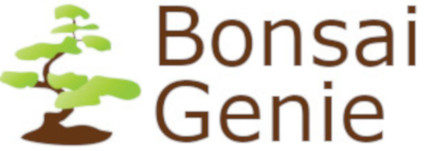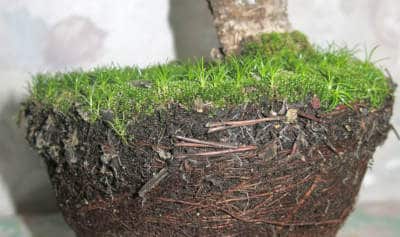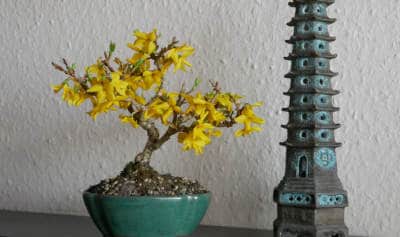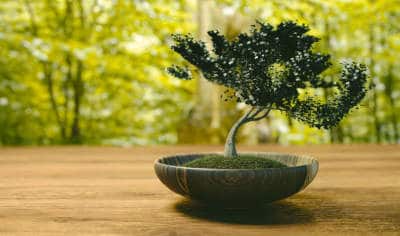What Diseases Can Affect Bonsai Trees?

I find myself worrying more and more about the health of my bonsai trees. I try to keep them healthy with the right soil mix, water and fertilizer, but sometimes they just become unhealthy, and I’m wondering if some of this is due to disease caused by infection of some sort.
What diseases can affect bonsai trees? Bonsai trees can be affected by many of the same infectious diseases as other plants. There are various bacterial, viral, and fungal infections that can cause health problems for bonsai trees, and some of these infections can be spread by insects.
As you would expect, bonsai trees can suffer from the same disease problems as other plants, but their small size and restricted amount of soil in the pots may make them more vulnerable to the effects of infection. I wanted to find out what these some of diseases are and what kinds of problem they cause,
Bonsai Tree Diseases
We are all constantly surrounded by bacteria, viruses and fungal spores. These disease-causing micro-organisms would like nothing more than to invade our bodies, and use us as somewhere to live and a source of food. This is why we need an immune system – to protect us from this.
It’s the same with plants, although we often forget this. Plants also get infected with these types of disease, and they also have an immune system to protect them from infection.
For commercial crops the effects of infection can be catastrophic. For our bonsai trees it can mean the loss of years of work and a cherished piece of living art.
I was also wondering if the reduced size of bonsai trees might make them more susceptible to disease and more likely to suffer from damage due to infections of various kinds. It’s hard to find information on this, but it seems reasonable.
Some of the main diseases in humans are caused by bacteria, viruses and fungi. I thought I would look at plant diseases, and bonsai diseases in particular, under these headings too.
Bacterial Infections
It turns out that there aren’t many bacteria that cause problems for bonsai trees, or plants in general. Most bacteria that live on bonsai trees are using dead material like the outer layers of bark as a source of food, so they don’t usually cause any problems for the tree.
Good Plant Bacteria
We’re used to thinking about bacterial infections in humans and the problems this can cause. There are also bacteria that live on and in our bodies that are important for health.
Just like the difference between good bacteria and bad bacteria, and the way they can affect humans, there are bacteria that can be helpful or harmful to plants.
Probably the best-known useful bacteria are the soil bacteria that help to make nitrogen available to plants in a form they can use. These are know as nitrogen-fixing bacteria.
You can even buy bonsai compost that has been enriched with these nitrogen-fixing bacteria to help ensure that nitrogen-containing nutrients are available for your bonsai trees.
Bacterial Diseases
Bacteria that can harm bonsai trees include various varieties of Erwinia, which infect woody plants. These bacteria produce digestive enzymes that destroy the texture of the plant tissue, leading to a condition called “soft rot”, where the plant tissues become soft and watery.
A type of bacteria that can cause a number of plant infections is Xanthomonas. This bacterial infection can lead to spots on leaves. This is known as bacterial leaf spot, which can cause damage to the plant.
There is some concern over the infection of bonsai trees with this bacteria. This is because of the risk that imported bonsai trees may be infected with Xanthomonas. The worry is that the infection may spread to other plants and, in particular, commercial crops.
Various bacterial infections that are harmful to plants cause problems for the plants by interfering with their fluid circulation systems.
This is a general feature of several bacterial infections, and is due to a substance they secrete that enables them to can congregate into assemblies called biofilms.
This substance can block the xylem vessels in plants that allows water to rise up from the roots, leading to poor plant health and even the death of your infected bonsai tree.
Viral Infections
Plants can also be infected by viruses, and like many bacteria they often don’t cause health problems for the plants. Interestingly, in commercial agriculture the main problems are caused by infection of perennial plants like fruit trees rather than crops that are grown from scratch each year.
I haven’t found much information on viruses that might cause problems for bonsai trees, but I will update this article when I do.
Fungal Infections
The cause of many health problems caused by micro-organisms seems to be fungal infection. However, although fungi can cause problems for bonsai trees, fungal growth like Micorrhiza fungi around the roots can encourage growth and enhance the health of the tree.
There are a number of fungal infections that can cause problems for bonsai trees. Examples include, Mildew, Black Spot, Leaf Spot and Rust. These conditions are caused by fungal spores germinating on the plant, and keeping your bonsai trees in a damp environment can make this more likely to occur.
Mildew develops in damp environments and has a dark mouldy appearance, which can be found on the leaves and around the base of exposed roots. It’s similar to the black discoloration that can be found around sinks in people’s homes. Mildew can cause the leaves to become damaged, and lead to impaired growth and even death of the tree.
With Black Spot the fungus mostly attacks the leaves and can be seen as black spots or larger patches. This often leads to the leaves turning yellow, becoming shriveled, and eventually falling off.
The main difference between Leaf Spot and Black Spot is that the spots may initially be grey, white or brown, usually turning black over time with loss of the leaves.
Rust, as the name suggests, is a fungal infection that causes rusty-colored bumps on the undersides of the leaves. Over time the leaves curl up and drop off the tree.
Insect Transmission
Something I hadn’t really thought about is the way that insects can transmit infections in plants. Because plants don’t move around very much there is less opportunity for infections to spread by direct contact, so insect vectors are important for making this happen.
You probably know that mosquitos transmit malaria when they bite an infected person, then bite someone else and transfer the infection to them. It seems that some bacterial infections like Phytoplasmas (sorry, there doesn’t seem to be a less scientific name for it) can be transmitted by insects.
While the insects are sucking sap out of the trees the Phytoplasmas bacteria they carry can infect the plant’s fluid circulation (the phloem). This infection can cause a number of problems; leaves growing instead of flowers, and leaf yellowing due to disruption of sugar delivery to the leaves.
Another way that insects can encourage infection in plants is due to the insects excreting some of the sap they suck out of the plants. This liquid is called honeydew, and it contains sugar and other nutritious substances.
The honeydew can be deposited on the leaves of the tree, and this can encourage fungal infection to develop on the leaves. It can also attract other insects like ants to the tree, which can lead to further damage.
Only Infection by Micro-Organisms
I had originally intended to look at other types of problems, such as insect pests, but even taking a very brief look at diseases caused by infection with micro-organisms has resulted in this post becoming quite long. I’ll take a look at insects and other pests in another post later on.
Other aspects that I’ll look at in further articles are things like the types of bonsai tree particularly at risk from various infections, things that can be done to prevent infection, and things that can be done to treat infected trees.






